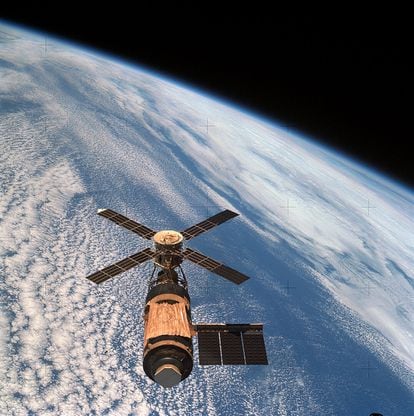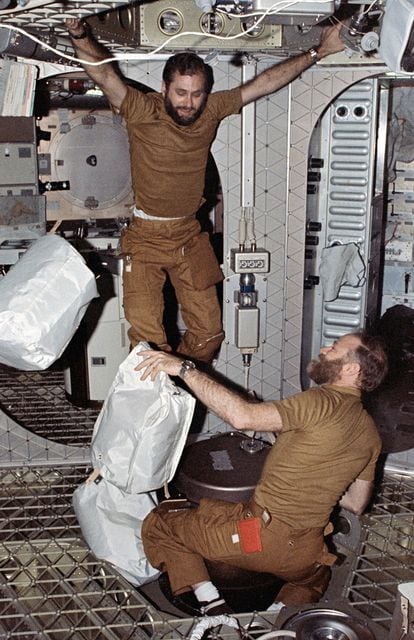The history of space exploration records at least two cases of mutiny by an astronaut crew. The first occurred in 1968, when the commander of the Apollo 7, Wally Schirra, cold, feverish and irritable, with his nose blocked by snot, disobeyed the re-entry protocol by dispensing with —he and his companions— the helmet for fear of suffering a ruptured eardrum due to the change in pressure. But the one considered first space strikewhich is now half a century old, was during the Skylab 4 mission, the third and last visit by astronauts to the space laboratory launched by NASA, from late 1973 to early 1974.
By then, the Soviet Union had already been ahead by a couple of years with Salyut 1 (which had a tragic end, with the death of its three crew members during the return to Earth) and had just put the second one into orbit. Skylab was built using an empty third stage of the lunar rocket saturn 5: a shell that offered a lot of space and NASA engineers had installed equipment inside to carry out dozens of experiments. The aim was to investigate everything from the behavior of the organism in microgravity conditions to new materials processing techniques. It also had on board a solar telescope and elements to make the stay of three astronauts more pleasant: individual bedrooms, a small kitchen and even a shower.
The launch of the laboratory did not go well: a gust of wind tore off its insulating shield and meteorite defense and one of its two solar panels. The other, although uninjured, had become stuck in a closed position. Much of the efforts of the first crew would be concentrated on installing a new protective sunshade and restoring the battered station to more or less regular operation.
The second crew continued repairs, but was able to develop an extensive program of experiments, including studying how spiders formed their webs in weightlessness. They were in space for 59 days, more than double that of the previous mission.
The next flight in the program was entrusted to a team of rookie astronauts, Gerald Carr, William Pogue and Edward Gibson: none of them had ever been to space, an important aspect in this story. The objective was to achieve a stay of almost three months. Being the last Skylab mission, the work program was very dense and, to make matters worse, the Sun, which should have been going through a period of relative calm, showed so much activity that it forced the observations with the telescopes to be multiplied.
There was so much to do that the astronauts were ordered to get to work almost immediately, without giving them enough time to get used to the sensation of weightlessness, new to the three of them. They were suffering from dizziness and vomiting for hours, but decided to hide it from the flight directors. When it was discovered through a conversation between them captured by the microphone, Alan Shepard, the legendary head of the astronaut office, gave them an official reprimand, the first that a crew received during a space trip.
The mission, then, started badly. Perhaps affected by the quarrel, the astronauts began to make trivial mistakes and fall further and further behind in their experiment program. It also didn't help that Houston was trying to micromanage, minute by minute, even the smallest details, to the indignation of the three men.
Typically, designing an experiment required a couple of years of preparation. To take advantage of that last flight, NASA had opened the season and received hundreds of proposals just a couple of months in advance. No wonder there were so many loose ends that researchers needed to give constant instructions to overwhelmed astronauts.

Every day at Skylab, about 40 sheets of instructions were received, from where to point the telescope to when to water a bean crop. As soon as they woke up, Carr, Pogue and Gibson found two meters of paper spit out by the teletype waiting for them, full of guidelines, formulas and procedures to be executed in the next 24 hours.
Pogue later recalled that because some of the experiments focused on astrophysics, the schedule was especially demanding: “They gave you a certain time and certain angles, etc., and you got that certain star. Well, if you don't do it in time, angles and everything are of no use. They become obsolete.”
Unbearable discomfort
The first two crews had, more or less, enjoyed their experience; the third, no. In addition, some small inconveniences became exasperating: the cans of food did not fit into the warmer and their contents always remained warm; the towels for personal hygiene seemed to be made of aluminum wool; The drinking water carried bubbles of dissolved gas that caused continuous winds. And the low atmospheric pressure forced communication by shouting, even when being only five meters away. The astronauts suffered from congestion caused by the lack of gravity that favored the accumulation of mucus in the sinuses. As a result, almost all the food was tasteless.
But the most annoying thing was that few things seemed to be in their place. Perhaps because the two previous crews had not been very careful in maintaining order. In theory, inventory cataloging was sacred. The Skylab carried about 40,000 items distributed in a hundred cabinets; In Houston, six people and a computer were in charge of knowing the location of everything at all times. But in practice a certain chaos had established itself on the space station.
And, to make matters worse, there was no lighting inside the drawers, only the light points from the ceiling. Finding any piece, from a camera to a tube of toothpaste, required scrutinizing its interior with a flashlight.
Under these conditions, work was delayed and rest periods decreased. They did not usually sleep more than 6 hours with 16-hour shifts of activity. In many cas
es, a single experiment—for example, photographing solar activity or the newly arrived comet Kohoutek—took three or four hours.

On Christmas Day, Skylab's trajectory kept it out of range of tracking stations for an entire orbit. That silence gave rise to the legend that the astronauts had disconnected the radio. In fact, on that same date, Carr and Pogue performed a grueling seven-hour spacewalk. Half jokingly, Houston suggested that they could take a day off, which they did, and the commander responded that they would “turn on the answering machine.”
Unanswered call
Carr remembered it like this: “One of the things we did was neglect our radios and we forgot to set them up for one of our passes, so when we got a signal, the people on the ground called us and we didn't answer them.” The media reported that the crew had refused to speak with the base.
The crew and mission control eventually held a conference call to voice their objections and reached a consensus on the path forward, which included prioritizing key research and putting routine tasks on a “shopping list” to be completed in any time of the day.
“That lightened the agenda, it took all the pressure off us. We were no longer racing against the clock to get things done. That really solved the problem,” Carr explained. “Flexifying the schedule allowed us to do the most important experiments, and the rest of the things were done when we could, rather than on a very tight schedule. “It worked wonderfully,” the astronaut celebrated some time later.
On repeated occasions, the astronauts had discussed with the controllers the need to rethink their work program. Sometimes, in an atmosphere of tension. Finally, they got their demands and many months later, one of the flight directors acknowledged that, indeed, the three crew members had been under too much pressure. The specialists drew many conclusions from this experience, such as the importance of psychology in these missions and the need to always have someone experienced on the ship.
In August 1976, Henry Cooper, a respected specialist in the space program, published an article in the magazine New Yorker in which he suggested that the stressed astronauts had gone on a kind of activity strike for an entire day. Later in his book A house in space, Cooper himself used the word “rebellion.” The reality was much less compromised. They had simply taken advantage of their day off. But the legend was too colorful to be completely extinguished and the episode of the three mutineers persisted for years.
Recently, the history division of the NASA published the story official of the episode, referring to the recorded conversations and the enormous amount of work carried out by the Skylab 4 crew. At 87 years old, Ed Gibson is the only survivor of the team. He continues to lament that the story of the mutiny remains what the public remembers most about their 84 days in space: In the end, the crew completed all their scheduled experiments and a few additional ones.
You can follow SUBJECT in Facebook, x and instagramor sign up here to receive our weekly newsletter.
#Skylab #years #passed #39strike39 #aboard #spacecraft
